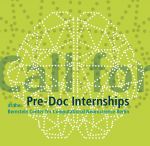- Graduate Programs
- Teaching
- Master Program
- Welcome to Berlin
- Information for Current Students
- Web Links
- Scholarships
- Testimonials of the Graduate Program
The list of principle investigators hosting Pre-Doc interns has still to be updated.
List of Principal Investigators for Pre-Doc internships

These principle investigators have capacity to host an intern (possible intern topics are listed below the names):
Radoslaw Cichy (Neural Dynamics of Visual Cognition)
- tba
Stefan Haufe (Brain and Data Science)
- tba
Livia de Hoz (Sensory Gating and Subcortico-Cortical Interactions)
The de Hoz lab is a systems neuroscience lab investigating the role of cortico-subcortical loops in statistical learning. We focus on the auditory system and perform awake and anaesthetized electrophysiological recordings (Neuropixels) and behaviour in mice.
- The role of cortico-subcortical loops in sound gating during sleep We offer a project on auditory gating during sleep. The project involves the analysis of population activity obtained via Neuropixels recordings from head-fixed awake and sleeping animals previously trained in a go/no-go task. In this specific project, we explore the role of the inferior colliculus (IC) and auditory cortex (AC) in gating sounds during sleep to better understand the interaction between the sensory input and memory. Previously we found that sound disrupts sleep-associated brain oscillations in rodents in a meaning-dependent manner (https://www.nature.com/articles/s41598-022-09457-6). We are now studying the responses of IC and AC to these sounds during sleep, in order to characterize the subcortico-cortical loop in which this gating presumably takes place. Neuronal activity is recorded with Neuropixels probes, and the mental state, with EEG, EMG, and pupil videos. This project offers the chance to get hands on experience on Neuropixels data as well as EEG/EMG and pupil videos, a combination of techniques relevant for modern neuroscience. Previous experience with electrophysiological data is welcome but not necessary. Important is a command of python/Matlab AND a very high level of motivation. This project’s data might be part of a future publication. If interested, please contact me (livia.dehoz@charite.de) to discuss more details of the project.
- The effect of cluster cutting (Kilosort) parameters on Neuropixels clusters When recording multiunit activity, cluster cutting is a common method to detect spikes and assign them to a putative neuron. This project, purely methodological, aims to assess the effect of different cluster parameters (different Kilosort versions) on the accuracy of clusters recorded with Neuropixels. The aim will be to apply different versions of Kilosort with different parameters to obtain clusters from Neuropixels-recorded neuronal activity obtained from cortical and subcortical auditory structures in awake head-fixed mice. The aim is to decide on the best parameters and establish whether these differ between structures and, possibly mental states (LFP and pupil size also available). The project offers a chance to become very familiar with Neuropixels data and its processing, and to relate cluster properties to spikes size and number, as well as structure and layer of origin. Previous experience with electrophysiological data is welcome but not necessary. Important is a command of python/Matlab AND a very high level of motivation. This project’s data would be of use to the wider neuroscience community. If interested, please contact me (livia.dehoz@charite.de) to discuss more details of the project.
Klaus Obermayer (Neural Information Processing)
-
Computational Models of Human Visual Information Sampling. This project aims to use computational modelling to learn from human visual information sampling strategies, and to apply these findings to computer vision. Potential topics include, for example, model-based investigations into inter-individual differences in human gaze behavior or into the relationship between task, gaze behavior, and scene memorization, using a computational framework developed in the group. The internship will take place in the context of the project ‘Visual Information Sampling’ within the Excellence Cluster Science of Intelligence (SCIoI).
Field Models of Slow Oscillations During Sleep. We are interested in the formation and propagation of slow oscillations (SOs) in the brain that appear during sleep as slow alternations between high- and low-activity states and that are thought to play an important role in memory consolidation. The data analysis part of the project aims at investigating spatio-temporal SO activity patterns in empirical intracranial brain data, where we combine embedding methods and detection algorithms to distinguish different types of patterns, e.g., travelling plane waves or spirals. In the computational modeling part we use neural field models to simulate SO patterns. Special focus will be on the investigation of different proposed mechanisms of SO generation (such as spike-frequency adaptation vs. hyperpolarization-activated currents) and how they affect the simulated activity patterns.
Silvia Viana da Silva (Cellular Circuits of Memory)
- Analysis of oscillations and spiking activity from mouse models of neurodegeneration
Keywords: hippocampus, memory, Alzheimer's disease
You are welcome to contact other BCCN Member labs and ask if they would host you. https://www.bccn-berlin.de/members-bccnberlin.html